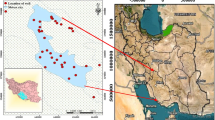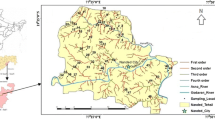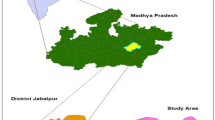Abstract
In many rural communities, groundwater is used to meet the water demand of the community and for the irrigation of cultivating areas. The quality of groundwater can be adversely affected by agricultural activities and finally groundwater quality may become unsuitable for human consumption and irrigation, as in the Harran Plain. Hence, monitoring groundwater quality by cost-effective techniques is necessary, as especially unconfined aquifers are vulnerable to contamination. This study presents an artificial neural network model predicting sodium adsorption ratio (SAR) and sulfate concentration in the unconfined aquifer of the Harran Plain. Samples from 24 observation wells were analyzed monthly for 1 year. Electrical conductivity, pH, groundwater level, temperature, total hardness and chloride were used as input parameters in the predictions. The best back-propagation (BP) algorithm and neuron numbers were determined for the optimization of the model architecture. The Levenberg–Marquardt algorithm was selected as the best of 12 BP algorithms and optimal neuron number was determined as 20 for both parameters. The model tracked the experimental data very closely both for SAR (R = 0.96) and sulfate (R = 0.98). Hence, it is possible to manage groundwater resources in a more cost-effective and easier way with the proposed model application.






Similar content being viewed by others
References
Abdi H, Valentin D, Edelman B, O’Toole AJ (1996) A Widrow–Hoff learning rule for a generalization of the linear auto-associator. J Math Psychol 40(2):175–182
Almasri MN, Kaluarachchi JJ (2005) Modular neural networks to predict the nitrate distribution in ground water using the on-ground nitrogen loading and recharge data. Environ Model Softw 20(7):851–871
Benerjee P, Prasad RK, Singh VS (2009) Forecasting of groundwater level in hard rock region using artificial neural network. Environ Geol 58:1239–1246
Clair TA, Ehrman JM (1996) Variations in discharge and dissolved organic carbon and nitrogen export from terrestrial basins with changes in climate: a neural network approach. Limnol Oceanogr 41(5):921–927
Das SK, Samui P, Sabat AK, Sitharam TG (2010) Prediction of swelling pressure of soil using artificial intelligence techniques. Environ Earth Sci 61:393–403
Devadas DJ, Rao NS, Rao BT, Rao KVS, Subrahmanyam A (2007) Hydrogeochemistry of the Sarada river basin, Visakhapatnam District, Andhra Pradesh, India. Environ Geol 52:1331–1342
El-Din AG, Smith DW (2002) A neural network model to predict the wastewater inflow incorporating rainfall events. Water Res 36(5):1115–1126
Erguvanli K, Yüzer E (1987) Groundwater Geology (Hydrogeology). İTÜ Maden Fakültesi, İstanbul, Turkey (in Turkish)
Gontarski CA, Rodrigues PR, Mori M, Prenem LF (2000) Simulation of an industrial wastewater treatment plant using artificial neural networks. Comput Chem Eng 24(2–7):1719–1723
Hagan MT, Demuth HB, Beale MH (1996) Neural network design. PWS Publishing, Boston
Hamed MM, Khalafallah MG, Hassanien EA (2004) Prediction of wastewater treatment plant performance using artificial neural networks. Environ Model Softw 19(10):919–928
Hudak PF (2000) Sulfate and chloride concentrations in Texas aquifers. Environ Int 26:55–61
Karaca F, Özkaya B (2006) NN-LEAP: a neural network-based model for controlling leachate flow-rate in a municipal solid waste landfill site. Environ Model Softw 21(8):1190–1197
Kendirli B, Cakmak B, Ucar Y (2005) Salinity in the Southeastern Anatolia Project (GAP), Turkey: issues and options. Irrig Drain 54(1):115–122
Lischeid G (2001) Investigating short-term dynamics and long-term trends of SO4 in the runoff of a forested catchment using artificial neural networks. J Hydrol 243:31–42
Maier HR, Dandy GC (1996) The use of artificial neural networks for the prediction of water quality parameters. Water Resour Res 32(4):1013–1022
Mjalli FS, Al-Asheh S, Alfadala HE (2007) Use of artificial neural network black-box modeling for the prediction of wastewater treatment plants performance. J Environ Manag 83(3):329–338
Mohammed M, Watanabe K, Takeuchi S (2010) Grey model for prediction of pore pressure change. Environ Earth Sci 60:1523–1534
Moral H, Aksoy A, Gokcay CF (2008) Modeling of the activated sludge process by using artificial neural networks with automated architecture screening. Comput Chem Eng 32:2471–2478
Nguyen D, Widrow B (1990) Improving the learning speed of 2-layer neural networks by choosing initial values of the adaptive weights. In: Proceedings of the international joint conference on neural networks, vol 3, pp 21–26
Onkal-Engin G, Demir I, Engin SN (2005) Determination of the relationship between sewage odour and BOD by neural networks. Environ Model Softw 20(7):843–850
Ozdogan M, Woodcock CE, Salvucci GD, Demir H (2006) Changes in summer irrigated crop area and water use in southeastern Turkey from 1993 to 2002: implications for current and future water resources. Water Resour Manag 20(3):467–488
Rodriguez MJ, Sérodes JB (1998) Assessing empirical linear and non-linear modelling of residual chlorine in urban drinking water systems. Environ Model Softw 14(1):93–102
Şahinci A (1991) Geochemistry of Natural Waters. Reform printing office, Izmir, Turkey (in Turkish)
Sahinkaya E, Özkaya B, Kaksonen AH, Puhakka JA (2007) Neural network prediction of thermophilic (65°C) sulfidogenic fluidized-bed reactor performance for the treatment of metal-containing wastewater. Biotechnol Bioeng 97(4):780–787
Strik DPBTB, Domnanovich AM, Zani L, Braun R, Holubar P (2005) Prediction of trace compounds in biogas from anaerobic digestion using the MATLAB neural network toolbox. Environ Model Softw 20(6):803–810
Subramani T, Elango L, Damodarasamy SR (2005) Groundwater quality and its suitability for drinking and agricultural use in Chithar River Basin, Tamil Nadu, India. Environ Geol 47(8):1099–1110
Toth E, Brath A, Montanari A (2000) Comparison of short-term rainfall prediction models for real-time flood forecasting. J Hydrol 239(1–4):132–147
TS 266 (2005) Water intended for human consumption (Turkish Standards Institution). Ankara, Turkey (in Turkish)
Turkish Ministry of Environment and Forestry (2004) The Turkish Water Pollution Control Regulation, The Turkish Official Gazette of 31 December 2004, No. 25687, Ankara, Turkey
Yesilnacar MI, Gulluoglu MS (2008) Hydrochemical characteristics and the effects of irrigation on groundwater quality in Harran Plain, GAP Project, Turkey. Environ Geol 54(1):183–196
Yesilnacar MI, Sahinkaya E, Naz M, Ozkaya B (2008) Neural network prediction of nitrate in groundwater of Harran Plain, Turkey. Environ Geol 56:19–25
Acknowledgments
This study was funded by the Scientific and Technological Research Council of Turkey (TÜBİTAK project no: 104Y188) and the Scientific Research Projects Committee of Harran University (HÜBAK project no: 603). The authors would like to thank Muhsin Naz, Yasemin Bayindir, Ozlem Demir, Atiye Atguden and Nuray Gok for their continuous help in the field and laboratory studies.
Author information
Authors and Affiliations
Corresponding author
Rights and permissions
About this article
Cite this article
Yesilnacar, M.I., Sahinkaya, E. Artificial neural network prediction of sulfate and SAR in an unconfined aquifer in southeastern Turkey. Environ Earth Sci 67, 1111–1119 (2012). https://doi.org/10.1007/s12665-012-1555-9
Received:
Accepted:
Published:
Issue Date:
DOI: https://doi.org/10.1007/s12665-012-1555-9




